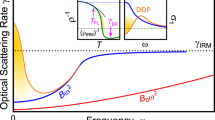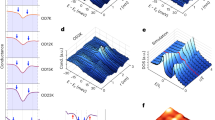Abstract
On cooling through the transition temperature Tc of a conventional superconductor, an energy gap develops as the normal-state charge carriers form Cooper pairs; these pairs form a phase-coherent condensate that exhibits the well-known signatures of superconductivity: zero resistivity and the expulsion of magnetic flux (the Meissner effect1). However, in many unconventional superconductors, the formation of the energy gap is not coincident with the formation of the phase-coherent superfluid. Instead, at temperatures above the critical temperature a range of unusual properties, collectively known as ‘pseudogap phenomena’, are observed2. Here we argue that a key pseudogap phenomenon—fluctuating superconductivity occurring substantially above the transition temperature—could be induced by the proximity of a Mott-insulating state. The Mott-insulating state in the κ-(BEDT-TTF)2X organic molecular metals3,4,5 can be tuned, without doping, through superconductivity into a normal metallic state as a function of the parameter t/U, where t is the tight-binding transfer integral characterizing the metallic bandwidth and U is the on-site Coulomb repulsion. By exploiting a particularly sensitive probe of superconducting fluctuations, the vortex-Nernst effect, we find that a fluctuating regime develops as t/U decreases and the role of Coulomb correlations increases.
This is a preview of subscription content, access via your institution
Access options
Subscribe to this journal
Receive 51 print issues and online access
$199.00 per year
only $3.90 per issue
Buy this article
- Purchase on Springer Link
- Instant access to full article PDF
Prices may be subject to local taxes which are calculated during checkout



Similar content being viewed by others
References
Tinkham, M. Introduction to Superconductivity 2nd edn (Dover Publications, Mineola, New York, 2004)
Timusk, T. & Statt, B. The pseudogap in high-temperature superconductors: an experimental survey. Rep. Prog. Phys. 62, 61–122 (1999)
Ishiguro, T., Yamaji, K. & Saito, G. Organic Superconductors 2nd edn (Springer, Berlin, 2006)
McKenzie, R. H. Similarities between organic and cuprate superconductors. Science 278, 820–821 (1997)
Lefebvre, S. et al. Mott transition, antiferromagnetism, and unconventional superconductivity in layered organic superconductors. Phys. Rev. Lett. 85, 5420–5423 (2000)
Kanoda, K. Metal–insulator transition in κ-(ET)2 X and (DCNQI)2M: Two contrasting manifestation of electron correlation. J. Phys. Soc. Jpn 75, 051007 (2006)
Mayaffre, H., Wzietek, P., Lenoir, C., Jerome, D. & Batail, P. C-13 study of a quasi-2-dimensional organic superconductor κ-(ET)2Cu[N(CN)2]Br. Europhys. Lett. 28, 205–210 (1994)
Powell, B. J. & McKenzie, R. H. Strong electronic correlations in superconducting organic charge transfer salts. J. Phys. Condens. Matter 18, R827–R866 (2006)
Caulfield, J. et al. Magnetotransport studies of the organic superconductor κ-(BEDT-TTF)2Cu(NCS)2 under pressure: the relationship between carrier effective mass and critical temperature. J. Phys. Condens. Matter 6, 2911–2924 (1994)
Kagawa, F., Miyagawa, K. & Kanoda, K. Unconventional critical behaviour in a quasi-two-dimensional organic conductor. Nature 436, 534–537 (2005)
Williams, J. M. et al. From semiconductor-semiconductor transition (42 K) to the highest T c organic superconductor, κ-(ET)2Cu[N(CN)2]Cl (T c = 12.5 K)]. Inorg. Chem. 29, 3272–3274 (1990)
Xu, Z. A., Ong, N. P., Wang, Y., Kakeshita, T. & Uchida, S. Vortex-like excitations and the onset of superconducting phase fluctuation in underdoped La2-xSrxCuO4 . Nature 406, 486–488 (2000)
Wang, Y. et al. High field phase diagram of cuprates derived from the Nernst effect. Phys. Rev. Lett. 88, 257003 (2002)
Wang, Y. et al. Dependence of upper critical field and pairing strength on doping in cuprates. Science 299, 86–89 (2003)
Wang, Y., Li, L. & Ong, N. P. Nernst effect in high-T c superconductors. Phys. Rev. B 73, 024510 (2006)
Sondheimer, E. H. The theory of the galvanomagnetic and thermomagnetic effects in metals. Proc. R. Soc. Lond. Ser. A 193, 484–512 (1948)
Pourret, A. et al. Observation of the Nernst signal generated by fluctuating cooper pairs. Nature Phys. 2, 683–686 (2006)
Logvenov, G. Y. et al. Anomalous Nernst effect in the mixed state of the two-band organic superconductors κ-(BEDT-TTF)2Cu[N(CN)2]Br and κ-(BEDT-TTF)2Cu(NCS)2 . Physica C 264, 261–267 (1996)
Analytis, J. G. et al. Effect of irradiation-induced disorder on the conductivity and critical temperature of the organic superconductor κ-(BEDT-TTF)2Cu(SCN)2 . Phys. Rev. Lett. 96, 177002 (2006)
Sasaki, T. et al. Low-temperature vortex liquid states induced by quantum fluctuations in the quasi-two-dimensional organic superconductor κ-(BEDT-TTF)2Cu(NCS)2 . Phys. Rev. B 66, 224513 (2002)
Nam, M.-S. et al. Angle dependence of the upper critical field in the layered organic superconductor κ-(BEDT-TTF)2Cu(NCS)2 (BEDT-TTF ≡ bis(ethylene-dithio)tetrathiafulvalene). J. Phys. Condens. Matter 11, L477–L484 (1999)
Carrington, A. et al. Low-temperature penetration depth of κ-(ET)2Cu[N(CN)2]Br and κ-(ET)2Cu(NCS)2 . Phys. Rev. Lett. 83, 4172–4175 (1999)
Lee, P. A., Nagosa, N. & Wen, X.-G. Doping a Mott insulator: physics of high-temperature superconductivity. Rev. Mod. Phys. 78, 17–85 (2006)
Emery, V. J. & Kivelson, S. A. Importance of phase fluctuations in superconductors with small superfluid density. Nature 374, 434–437 (1995)
Powell, B. J. & McKenzie, R. H. On the relationship between the critical temperature and the London penetration depth in layered organic superconductors. J. Phys. Condens. Matter 16, L367–L373 (2004)
Lang, M., Toyota, N., Sasaki, T. & Sato, H. Magnetic penetration depth of κ-(BEDT-TTF)2Cu[N(CN)2]Br, determined from the reversible magnetization. Phys. Rev. B 46, 5822–5825 (1992)
Larkin, M. I., Kinkhabwala, A., Uemura, Y. J., Sushko, Y. & Saito, G. Pressure dependence of the magnetic penetration depth in κ-(BEDT-TTF)2Cu(NCS)2 . Phys. Rev. B 64, 144514 (2001)
Pratt, F. L. & Blundell, S. J. Universal scaling relations in molecular superconductors. Phys. Rev. Lett. 94, 097006 (2005)
Doniach, S. Quantum fluctuations in two-dimensional superconductors. Phys. Rev. B 24, 5063–5070 (1981)
Anderson, P. W. The resonating valence bond state in La2CuO4 and superconductivity. Science 235, 1196–1198 (1987)
Powell, B. J. & McKenzie, R. H. Half-filled layered organic superconductors and the resonating-valence-bond theory of the Hubbard-Heisenberg model. Phys. Rev. Lett. 94, 047004 (2005)
Gan, J. Y., Zhang, F. C. & Su, Z. B. Theory of gossamer and resonating valence bond superconductivity. Phys. Rev. B 71, 014508 (2005)
Ussishkin, I., Sondhi, S. L. & Huse, D. A. Gaussian superconducting fluctuations, thermal transport, and the Nernst effect. Phys. Rev. Lett. 89, 287001 (2002)
Acknowledgements
Work at Oxford is funded by the EPSRC. Work at Argonne National Laboratory is supported by the Office of Basic Energy Sciences, Division of Materials Science, US Department of Energy. A.A. is supported by the Royal Society. We thank J. M. Bhaseen, K. Burnett, P. M. Chaikin, J. T. Chalker, L. Forro, D. Jaksch, N. P. Ong and I. A. Walmsley for discussions.
Author information
Authors and Affiliations
Corresponding author
Ethics declarations
Competing interests
The authors declare no competing financial interests.
Rights and permissions
About this article
Cite this article
Nam, MS., Ardavan, A., Blundell, S. et al. Fluctuating superconductivity in organic molecular metals close to the Mott transition. Nature 449, 584–587 (2007). https://doi.org/10.1038/nature06182
Received:
Accepted:
Published:
Issue Date:
DOI: https://doi.org/10.1038/nature06182
This article is cited by
-
Emergent anisotropy in the Fulde–Ferrell–Larkin–Ovchinnikov state
Nature Communications (2022)
-
Polarized Time-Resolved Spectroscopy of Electronic Phase Separation in a Dimer-Mott Organic Insulator
Journal of Superconductivity and Novel Magnetism (2020)
-
Ultrafast Carrier Dynamics in an Organic Superconductor κ-(BEDT-TTF)2Cu[N(CN)2]Br by Spectrally Resolved Pump-Probe Spectroscopy
Journal of Superconductivity and Novel Magnetism (2020)
-
A Simple Silver Nanowire Patterning Method Based on Poly(Ethylene Glycol) Photolithography and Its Application for Soft Electronics
Scientific Reports (2017)
-
Superconducting fluctuations in organic molecular metals enhanced by Mott criticality
Scientific Reports (2013)
Comments
By submitting a comment you agree to abide by our Terms and Community Guidelines. If you find something abusive or that does not comply with our terms or guidelines please flag it as inappropriate.



